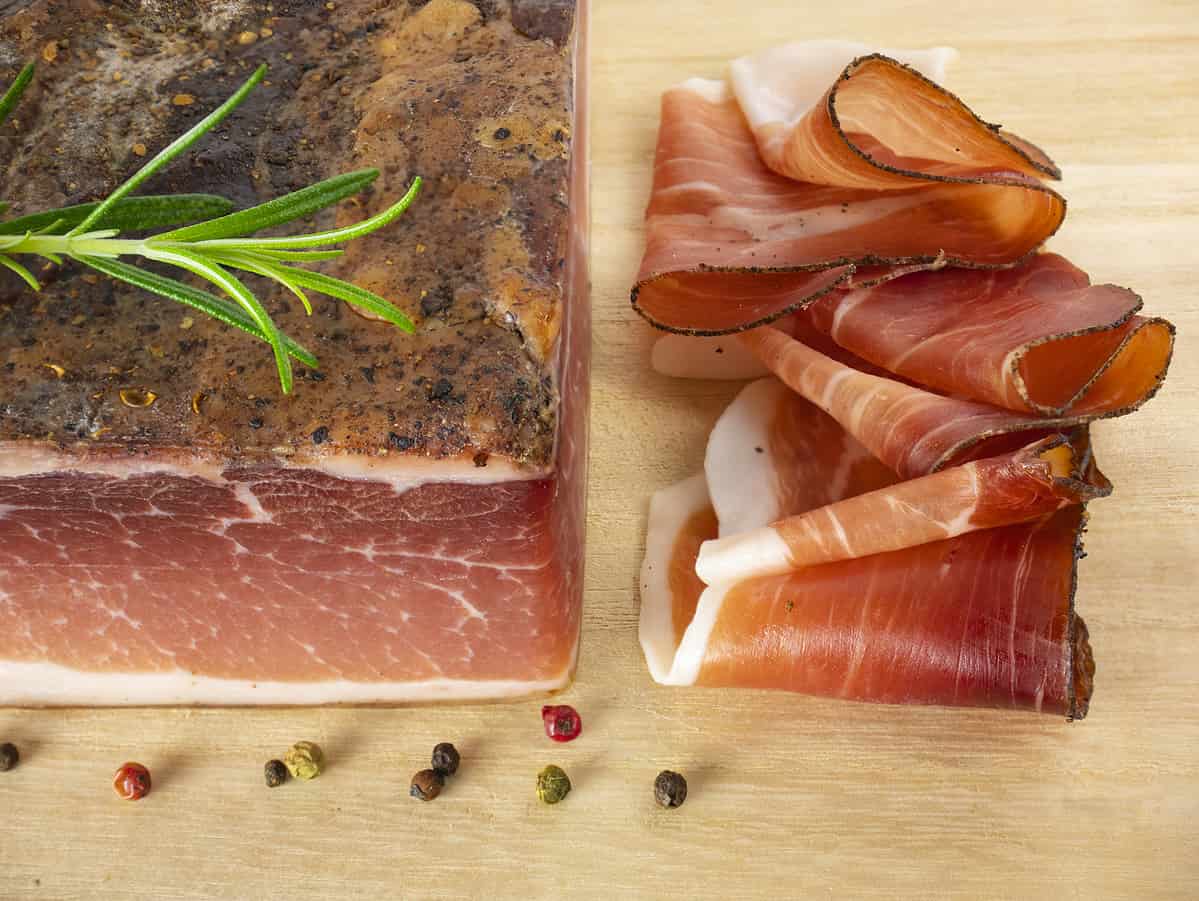The star of the show at many holiday festivities, ham is a beloved protein that graces tables at everything from the standard Friday night family dinner to the Thanksgiving feast alongside the green beans almondine and mashed potatoes. But the variations on ham preparation runs the gamut — from salt-cured Italian hams like speck and prosciutto to the gorgeous Ibérico hams of Spain and Portugal.
The real question is: is ham healthy? While it obviously doesn’t offer the nutritional value of leaner proteins such as chicken and turkey, it does offer proteins, minerals, and other nutrients that support our health. With that said, ham is processed meat — meaning it’s preserved by salting, wet or dry curing, or smoking the meat, which means there are chemical preservatives (such as nitrates) added. In short, eating a lot of ham could have adverse effects on your health, but eating it in moderation offers some notable health benefits. We’re breaking down the science-based health advantages and disadvantages and weighing in on which preparations might lend themselves to a healthier diet.

©Mironov Vladimir/Shutterstock.com
What is Ham, and Where Does it Come From?
First off, and without getting overly graphic, ham can be cut from a pig’s hind leg or some other part. Despite this fact (and perhaps the most common misconception), ham differs from bacon. Bacon is cut from parts aside from a pig's legs. For example, bacon might be cut from the back or belly. Bacon is a specific term, while “ham” tends to be a bit more broad. Nevertheless, they are both pork, and they are both salted, cured, and/or smoked in some way, so it's not surprising that many people assume they are one and the same.
Additionally, ham is a lot more versatile than you might realize. To give you an idea of the range of flavor profiles ham can offer, here is a list of some of the world's most popular iterations and where they come from:
- Country Ham: Primarily associated with classic Southern cooking in The United States, this type of ham was developed during Colonial times. Country Ham is heavily salted and cured pork leg. It is cured in a humid environment and aged for as long as three years, giving it an intensely salty taste.
- Jamón Ibérico: A delicacy found in both Portugal and Spain, this ham comes from a type of free-roaming pig (black Ibérico pigs, more specifically) that are raised on a diet consisting of feed mixed with corn and acorns. This produces a cured ham that's dark red and marbled, with a sweet, nutty, mildly salty flavor. Interestingly, there are actually four types of jamón ibérico, depending on the diet of the pigs used to make it!
- Jamón Serrano: This type of ham is produced in Spain using traditional methods that can be traced back to Roman times. The process of curing begins with salting. The ham is subsequently washed, followed by drying and curing it for over a year. It is surprisingly less salty than many of its counterparts. When cut open, it offers up a pink or purple color. Thinly sliced and set atop a thick piece of crusty bread with a drizzle of Spanish olive oil is perfection!
- Prosciutto: Time and tradition merge to create what is surely one of the most beloved cured hams in the world. This delicious ham comes from pigs bred in 10 specific Northern and Central regions in Italy. The pigs are fed a particular diet (of cereal, grains, and Parmigiano Reggiano cheese whey) and meet very high standards. One of the factors that lead to its exceptional flavor profile is the curing process, thanks to its salting by the local expert Salt Master (or Maestro Salatore), who carefully measures the sea salt used for its preservation. Prosciutto pairs delightfully with fruit — a sweet and savory combination that simply wows. That's why you'll find “Prosciutto e Melone” offered as an antipasto on many an Italian menu. It's a dish that has been served for over 3,000 years. Talk about popular!
- Speck: Salt-cured pork from a mountainous region in Northern Italy, Speck is also smoked after it's cured. The cut of meat comes from the pig's hindquarters. It is typically slathered in a rub made up of salt, pepper, juniper berries, and other spices. It is dark, highly marbled, and has a somewhat smoky taste.
- Spiral Ham: Essentially, spiral ham is a bone-in ham sliced with a spiral-slicing machine. The machine thinly carves the meat while maintaining its shape for maximum serving aesthetic. Most popularly, spiral ham is served with a honey or brown sugar glaze. If you grew up eating ham on Thanksgiving, it was likely this style!
- Schwarzwälder Schinken: Known more commonly in the States as “Black Forest ham,” this is the best-selling smoked ham in Europe. It is generally spiced using traditional recipes that incorporate ingredients such as salt, juniper berries, garlic, pepper, and coriander. It is then cold-smoked with fir wood that comes from Germany's Black Forest. When you slice into it, you might be surprised to find it possesses a vivid red color — a result of the smoking style.

©iStock.com/Marco_de_Benedictis
What are the Health Benefits of Ham?
Ham is high in protein yet low in carbohydrates, fiber, and fat. It’s also low in calories if eaten on its own. Comparatively speaking, it is also higher in iron and other B vitamins than chicken or fish. However, it tends to be less nutrient-filled than red meat options such as beef. Nevertheless, it's a great source of amino acids, zinc, phosphorous, and potassium, which boost energy and heart health, and fend off infections.
If you're still skeptical about ham's health benefits, choose an uncured ham. This can help cut down on the number of added preservatives you consume. Typically labeled as “fresh,” these hams are a more natural or organic choice. You can always add seasoning later!
What are the Health Detriments of Ham?
Eating too much of anything can be a detriment. This Is particularly true with processed meats like bacon, hot dogs, or even deli meats, which aren't ideal for your health thanks to a pretty extensive dose of sodium and preservatives. In fact, there are quite a few studies that link processed meats to cancer, diabetes, and heart disease. Additionally, many of the spiral hams eaten in the United States are glazed or brown sugar-cured. This means there’s a fairly significant dose of sugar being added on as well. Moderation is the name of the game on this one. Many (or even most) of the commercial hams are preserved with nitrates. Keep an eye out for ham options that are lean with low sodium.

©Elena Veselova/Shutterstock.com
Important Takeaways
- If you enjoy ham, there are plenty of tasty options coming from all over the world. Each is cured using different methods (some that date back to the Roman Empire) and spices.
- Too much ham can introduce a significant and unhealthy level of sodium and preservatives into your diet.
- Despite its health disadvantages, eating ham in moderation can offer health benefits such as boosted energy, increased heart health, and strengthened immunity.
Up Next:
- How to Cook a Ham Perfectly, 4 Ways
- Genoa Salami vs. Hard Salami: Two Unique Differences Including Taste and Nutrition
- Is Chicken Salad Healthy, Actually? What Science Says
The image featured at the top of this post is ©Elena Veselova/Shutterstock.com.

